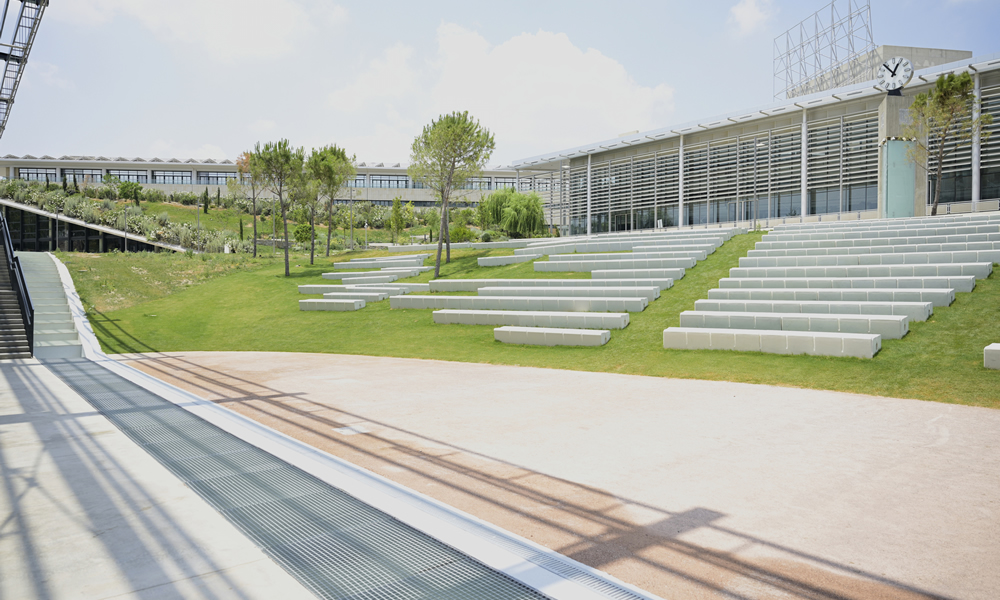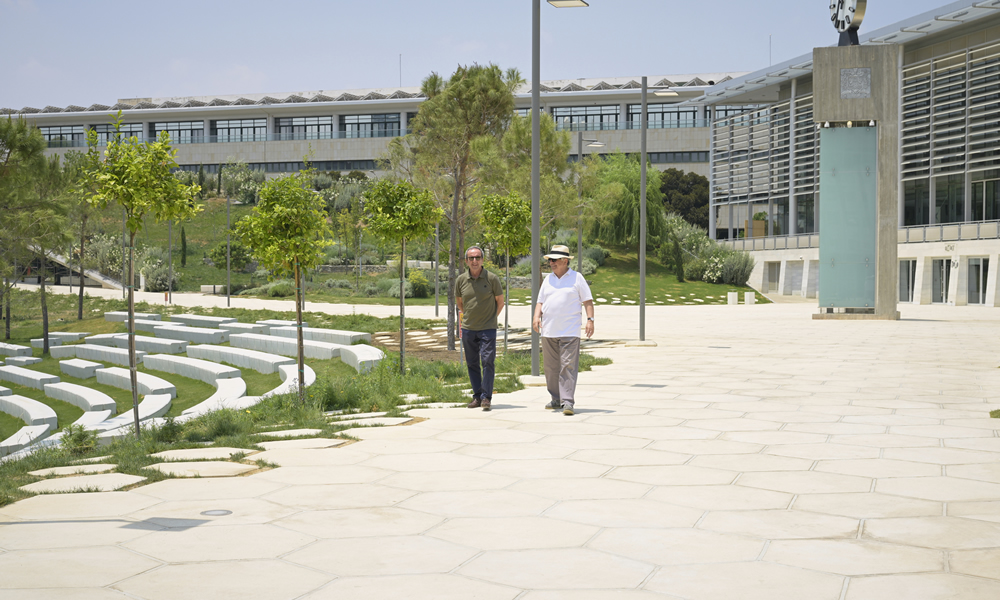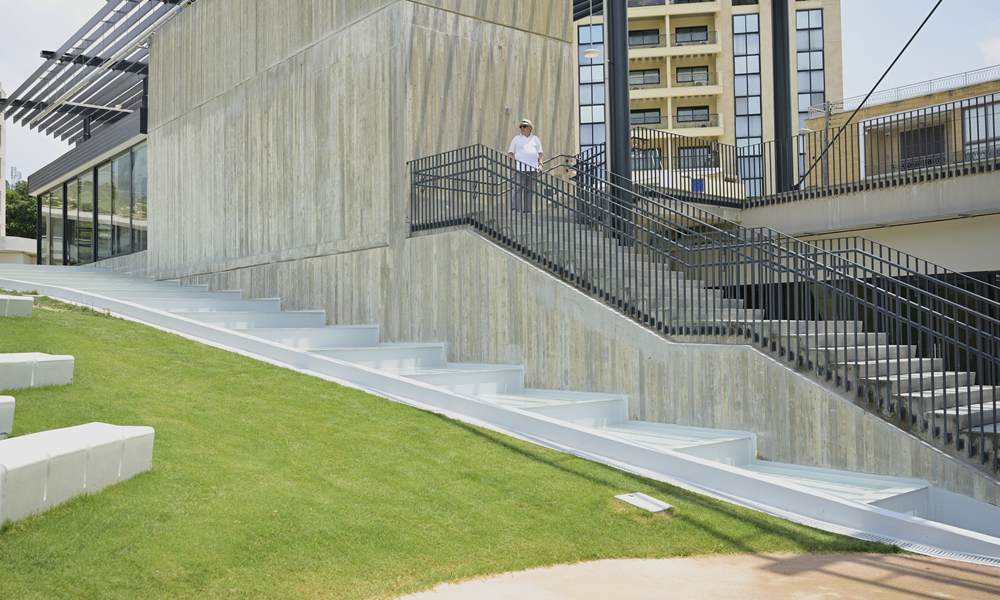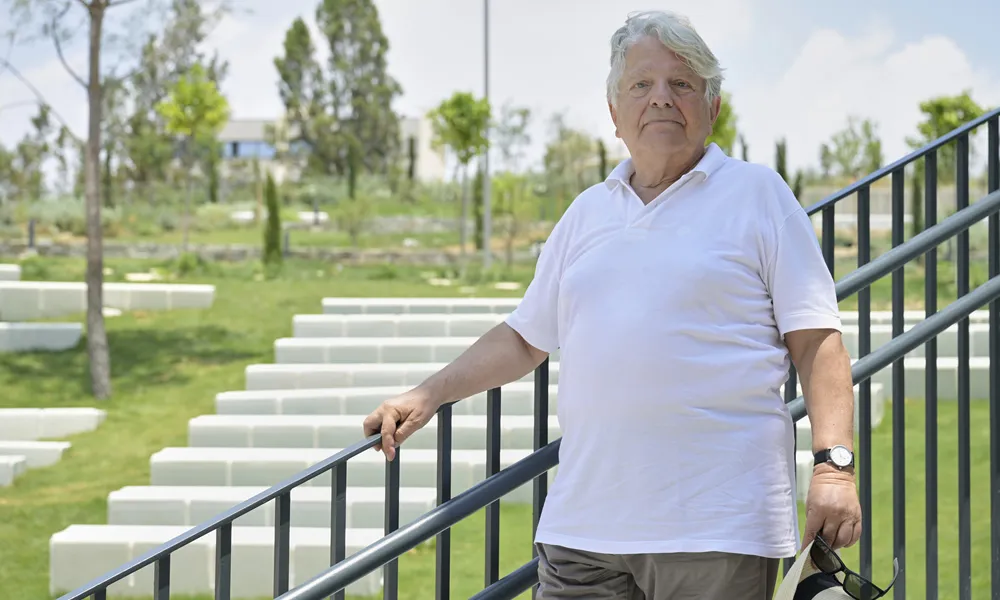A New Heart for Nicosia
During the term of Mayor Eleni Mavrou, Nicosia held its referendum. Under Mayor Constantinos Yiorkadjis, and in the midst of an economic crisis, determination was shown to keep the project alive and see it through. With Mayor Charalambos Prountzos came the inauguration and some pending tasks: the tree planting along Evagorou Street as foreseen in the original plan, the proper maintenance of the entire project, and, last but not least, the enduring task of drawing people into the new space and making it part of the city’s living rhythm, a responsibility that calls for love and faith in what has been created.
In short, the stars aligned for the old GSP football stadium in Nicosia to be reborn. Three governments and three mayors later, the capital now has, in 2025, an urban plaza with green areas and spaces for recreation, as well as an underground parking facility designed for electric vehicles.
For its creators, it is “a lung of life, shaped on a sculpted landscape where nature dominates and the human presence remains discreet.” Others see too much concrete and too little green. In the age of TikTok, everyone is a critic, an expert, and a politician.
Politis to the Point spoke with Greek architect Yannis Kizis, head of the architectural team, in a long conversation presented in the form of “frequently asked questions.” It seeks to answer skeptics and the habitually grumpy while giving citizens a clearer understanding of the capital’s newest landmark. We met at the inauguration, where he spoke about how a team of four generations of architects, himself, Cypriot architect Gregoris Patsalosavvis, Efthymios Dougkas, and Costadis Kizis, won the competition and carried it through with confidence and love for Cyprus.
Yannis Kizis is no stranger to Cyprus. His bond with the island goes back long before the GSP project, to his student and professional years, when he first came to understand how distinct the country is from Greece.
What is your relationship with Cyprus?
“My relationship with Cyprus began during my years at the National Technical University of Athens and my friendships with Cypriot student fellows. Later, in 2002, I was invited to chair a jury for an architectural award organised by Cyprus’ Town Planning Department, something unprecedented for a state body. For a Greek architect, it was unexpected to see a public authority rewarding architecture. It was both an honour and a responsibility. I stayed and travelled around the island visiting projects, and I began to understand a society quite different from Greece.”
What was your approach to the GSP project when it came up?
“The process of understanding a design problem does not differ whether you are in Nicosia, Crete, or Prague. You have to understand the local history, how it fits into the broader one, and what people expect from their place. When the competition was announced, I spoke with Grigoris Patsalosavvis and we created a mixed team.”
Do you think some architectural competitions are decided before they even begin?
“Of course it happens. We have all seen it. But there is no point in dwelling on that. What matters is preparation. Without it, the result will always be shallow.”
When a city asks its people
The case of the old GSP stadium was unique in Cyprus: its future was decided through a public referendum. For Kizis, it was a rare example of civic maturity.
How do you view that experience today?
“It was a world first,” he recalls. “But referenda need preparation, not questions that no one understands. Here, the residents reacted wisely. They wanted greenery, a park, a lung for the city. It was perhaps the first time that Nicosia’s civil society took an active role in shaping its own urban space.”
The referendum also sparked a broader debate, Kizis said: “It raised questions about how the city grows, where its boundaries lie, and which spaces deserve to remain public. These are the discussions that help a society evolve.”
How has the city developed to this point?
“After 1960, Nicosia expanded southward without a coherent master plan. Its growth followed the old agricultural plots, the existing roads, and the patterns of land ownership. There was never a unifying vision to connect the old and new parts of the city, nor the courage to redesign it from the ground up. Development therefore progressed in fragments, driven by private initiative, and failed to create the landmarks that give a city its identity. The walled city, no matter how labyrinthine, has character, history and proportion. A modern city needs planning to acquire its own character. Isolated projects are not enough”.

one trace of its past, its inward character.
And what did the referendum ultimately show?
“The residents of the centre reacted with maturity and sensitivity. They wanted the space to remain open and public, to belong to the city. At the same time, they understood that the project needed an economic base. So they accepted small-scale commercial uses, about 1,500 square metres, as a realistic balance between function and recreation. The municipality organised surveys and public discussions, and from that process emerged a public space with its own identity”.
From competition to construction
The 2011 design competition drew almost seventy proposals from across Europe.
What element made your proposal stand out?
“There was a clear dilemma. When you are asked to include 1,500 square metres of commercial uses, it becomes a building problem. But at the same time, you are asked for a park and a plaza. How do you balance the two? Most proposals had visible buildings and open areas. Ours was different. You saw no buildings at all, even though they existed within the landscape. That was what convinced the jury.”
The project soon encountered the harsh reality of the financial crisis. The competition had set clear parameters: a fixed balance between open space and built area, and a total budget of around fifty-five million euros. Then the recession struck, freezing public works across the country. Many projects were abandoned altogether, but the GSP redevelopment survived thanks to the determination of Mayor Constantinos Yiorkadjis. “He told us, cut three basement levels so we can move forward,” Kizis recalls. It proved a wise and balanced decision. The revision eliminated space for a thousand cars, significantly reduced the cost, and even had a positive impact on the environment.
Why was cutting the basements so crucial?
“If we had gone deeper, the cost would have skyrocketed because of the water table. The Pedieos river passes nearby, and the groundwater appears at six and a half metres, not ten as originally assumed. That was the reality. The final solution was both realistic and friendly to the city.”
Memory and terrain
The new park, Kizis says, preserves only one feature of the old stadium: its inward focus. “Like every arena, the GSP was inward-looking,” he explains. “By raising the edges to create slopes and sinking the ground to form an amphitheatre, the park keeps that same sense of enclosure. A person walking along Evagorou Street sees the open gaps, catches sight of the amphitheatre, and feels invited to step inside. The paths were designed so that visitors move through the space rather than around it”.
One element of the original plan, however, was never realized: the intended link with the Cyprus Theatre Organisation. “Our first proposal included two bridges connecting the square to the theatre’s terrace,” Kizis recalls. “Bureaucracy blocked the idea, treating the theatre and the plaza as separate entities. Still, the project gives the theatre the open space it needed for performances and gatherings.”

The two senior members of the team, reflecting on how public architecture can reconnect people
with their city and on the patience such work demands to truly mature.
Concrete, green and patience
Public debate focused on the amount of concrete and the absence of mature trees. Kizis takes a longer view.
“Concrete is the building material of the twentieth and twenty-first centuries. It is not to blame for the poor quality of our cities; ignorance is. Reinforced concrete is what steel was in the nineteenth century. The Eiffel Tower was once called a monster and is now the symbol of Paris. It is not the material that matters but the way it is used.”
As for the greenery, he says, “It is a little ironic. The same people who pave their yards with tiles complain that public projects have too much concrete. Nicosia has its moat, but in its newer areas there are no organised parks. The demand for greenery is natural, but trees need time. You cannot plant a forest overnight.”
“The pergola needs three to five years to be fully covered. The project is a living organism. It needs patience.”
The 'Sinking Park' Myth
Politis to the Point asked architect Yannis Kizis to respond to recent public discussion and claims that the new GSP Park was “sinking,” and to explain what is really happening beneath the surface. “People easily fall prey to misinformation and gossip,” he says.
“The truth is that this project is neither purely architectural nor purely landscape. The structural part is complete and solid. What takes time is the soil itself.”
He explains that the park’s design deliberately allows large trees to grow in natural ground rather than in shallow, artificial beds.
“To achieve that, we built deep wells within the structure that reach down to the natural foundation level,” he notes. “They were filled with earth that allows underground moisture to rise to the roots. Although mechanically compacted, this soil needs time to settle naturally. That is not collapse; it is nature stabilising itself. The park simply needs patience and love.”
The architecture of a city
When asked which Nicosia buildings he admires, he answers immediately. “The Zina Palace and the Faneromeni building at the end of Ledra Street, near the crossing. They are both products of the 1960s, works of quality and dignity that are now rare. If the municipality lists them as heritage, it will save an important part of the city’s architectural identity.”
Not everything old deserves to be preserved, he adds. “These are two different matters: multiple ownership and heritage listing. Not all old buildings are worth keeping. Cities must evolve. What matters is to have committees capable of sound judgment. Inside the old walls, there are still many buildings that deserve protection.”

modern city that can shape beauty when guided by knowledge.
A park for the next generation
From the roar of football crowds to the sound of footsteps and conversation, Nicosia’s heart has changed rhythm. Where a stadium once stood, there is now an open landscape for rest, walking and gathering.
“That is the essential question, its use,” he says. “We did our part and now we want to see what we dreamed of come alive. Personally, I want to see it full of young people, with their own ideas and energy. I hope they grow up in peace and make it their own.”
As Yannis Kizis puts it, “The old GSP has become a new lung of life at the city’s ground zero, a space that breathes for the capital and invites its people to breathe with it.”
